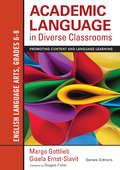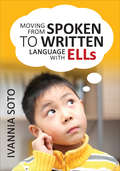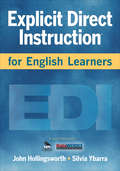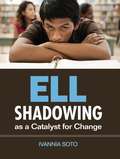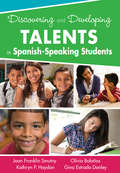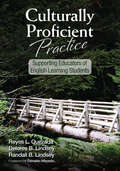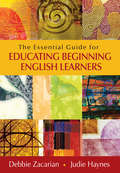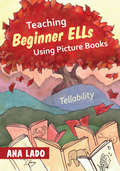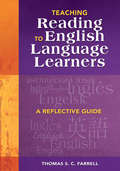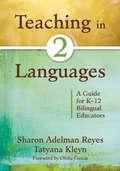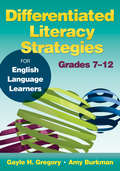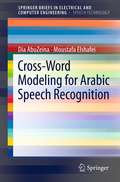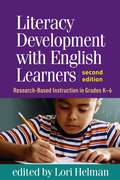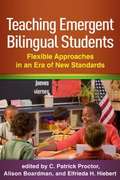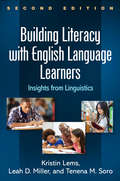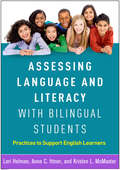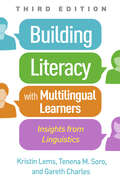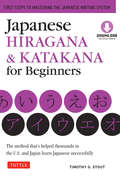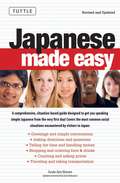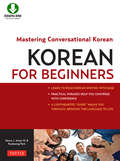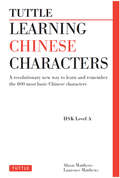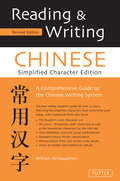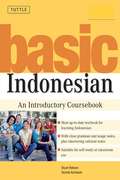- Table View
- List View
Academic Language in Diverse Classrooms: Promoting Content and Language Learning
by Dr Margo Gottlieb Gisela Ernst-SlavitMake every student fluent in the language of learning. The Common Core and ELD standards provide pathways to academic success through academic language. Using an integrated Curricular Framework, districts, schools and professional learning communities can: Design and implement thematic units for learning Draw from content and language standards to set targets for all students Examine standards-centered materials for academic language Collaborate in planning instruction and assessment within and across lessons Consider linguistic and cultural resources of the students Create differentiated content and language objectives Delve deeply into instructional strategies involving academic language Reflect on teaching and learning
Moving From Spoken to Written Language With ELLs
by Ivannia M. SotoMastering spoken language is the key to writing success for English Language Learning ELLs struggle to meet the writing demands of the Common Core State Standards. In this book, ELL expert Ivannia Soto demonstrates how oral language development is the key to building writing skills. She offers educators a powerful set of tools for implementation at both classroom and policy levels, including: • Exciting spoken techniques such as Socratic Seminar, Frayer model and Think-Pair-Share that build vocabulary and extend into academic writing • Approaches to teaching three essential styles of writing: argumentative, procedural, and narrative • Sample lesson plans and graphic organizer templates
Explicit Direct Instruction for English Learners
by John R. Hollingsworth Silvia E. YbarraBoost achievement for English learners in all subject areas! Building ELLs' language skills while teaching content is about to get easier. Hollingsworth and Ybarra combine the best of educational theory, brain research, and data analysis to bring you explicit direct instruction (EDI): a proven method for creating and delivering lessons that help students learn more and learn faster. Through classroom examples and detailed sample lessons, you'll learn how to: Craft lessons that ELs can learn the first time they're taught Check for understanding throughout each lesson Embed vocabulary development across the curriculum Address listening, speaking, reading, and writing in all lessons
ELL Shadowing as a Catalyst for Change
by Ivannia M. SotoExperience a day in the life of an ELL What if you could barely understand what your teacher was saying? ELL shadowing helps teachers experience the classroom from the student’s point of view. The author describes how to implement this easily accessible form of professional development, outlines specific strategies for adapting instruction to engage ELLs, and provides supporting videos on a companion website. Benefits include: Increased teacher sensitivity to ELLs’ school experiences A heightened sense of urgency to help ELLs learn academic language and content Improved classroom instruction that spreads throughout schools and districts More engaged students who are more likely to stay in school and reach their potential
Discovering and Developing Talents in Spanish-Speaking Students
by Joan F. Smutny Kathryn P. Haydon Olivia G. Bolanos Gina M. Danley¡Atención! Recognize the strengths of Spanish-speaking students! How do you nurture the gifts and talents of the growing population of Hispanic students? This book provides teachers and leaders with the skills needed to uncover each child’s abilities and ultimately boost achievement for gifted Spanish-speaking students. Packed with strategies that teachers can use immediately to enhance instruction and assessment, this book shows how to: Recognize students’ unique strengths Identify and develop the gifts of bilingualism and different cultures Create challenging learning experiences for every student in the class Adapt tools and strategies to meet each learner’s unique needs Connect with parents and the greater Spanish-speaking community
Culturally Proficient Practice: Supporting Educators of English Learning Students
by Reyes L. Quezada Delores B. Lindsey Randall B. LindseyHelp your English learning students achieve academic success! Designed to empower educators to become agents of change in their classrooms, schools, and communities, this guide introduces the principles of Cultural Proficiency and how they can help improve educators’ ability to effectively teach English language learners. This book features: <p><p> Activities that build core Cultural Proficiency skills and promote personal transformation <p> A chapter-by-chapter rubric for working effectively with English learning students <p> A conversation-starting case story featuring the River View School District <p> Strategies for using action research to improve the success of English learning students
The Essential Guide for Educating Beginning English Learners
by Debbie Zacarian Judie HaynesPut all English learners on the path to success—right from the start! As more beginning ELs enroll in schools every year, educators need a realistic framework for addressing the varied needs of this growing population. In this practical resource, the authors provide templates, tools, and vignettes illustrating real-world challenges to help teachers and administrators: Learn strategies for teaching beginning level ELs across the curriculum Create a welcoming environment for students and families Reach out to students from both literacy and non-literacy-oriented homes Design programs that meet the needs of beginning ELs and students with limited or interrupted formal education (SLIFE)
Teaching Beginner ELLs Using Picture Books: Tellability
by Ana L. LadoPicture your beginning ELLs reading their way to success! For beginning ELLs, a picture really is worth a thousand words! Picture books are useful tools for building important language and social foundations that students may miss through traditional instruction. Ana Lado provides all the tools you’ll need to engage ELLs of any age with picture books, including how to: Design lessons around picture books Select appropriate titles using specific criteria Incorporate fun and engaging strategies like singing and reenacting Access the book’s searchable online database to find the right book Integrate picture-book learning to facilitate development of English Language Proficiency
Teaching Reading to English Language Learners: A Reflective Guide
by Thomas S. FarrellThis resource offers practical methods for helping ELLs succeed in reading, with strategies to increase fluency and comprehension, teach vocabulary and text structure, and more.
Teaching in Two Languages: A Guide for K–12 Bilingual Educators
by Sharon Adelman Reyes Tatyana KleynGrounded in the latest research, this book provides classroom-ready strategies for balancing instruction in two languages and meeting the unique challenges of educating English language learners.
Differentiated Literacy Strategies for English Language Learners, Grades 7–12
by Gayle H. Gregory Amy J. Burkman100 ways to keep adolescent ELLs engaged This versatile handbook is for middle school and high school educators who need to differentiate literacy instruction for adolescent ELL students at various stages of literacy competency. Adapted from the highly successful Differentiated Literacy Strategies for Student Growth and Achievement in Grades 7–12, the authors use brain-based strategies and texts that appeal to older learners who may have had interrupted formal education or come from newly arrived immigrant populations. More than 100 hands-on tools help teachers develop students’ competencies in: Content areas, including vocabulary, concept attainment, and comprehension Technology, such as information searching, evaluation, and synthesis Creative applications and 21st century skills ·
Agentes secretos y el mural de Picasso
by Mira Canion David BennettPablo Picasso's mural Guernica is on display at the 1937 International Exposition. Both sides of the Spanish Civil War quickly realize that the painting contains clues to the whereabouts of the supernatural Spear of Destiny. Its occult power can change the outcome of the Civil War, just as it has done in other battles throughout history. As Paula's imagination begins to decipher the hidden symbols, Francisco Franco's secret agents are not far behind her. They are ready to capture the Spear at the most opportune moment, convinced that impulsive Paula will betray her quest for the Spear. Belonging to the genre of language learner literature, this is an easy Spanish reader containing just 100 new vocabulary words and many English-Spanish cognates.
Cross-Word Modeling for Arabic Speech Recognition (SpringerBriefs in Speech Technology)
by Dia Abuzeina Moustafa ElshafeiCross-Word Modeling for Arabic Speech Recognition utilizes phonological rules in order to model the cross-word problem, a merging of adjacent words in speech caused by continuous speech, to enhance the performance of continuous speech recognition systems. The author aims to provide an understanding of the cross-word problem and how it can be avoided, specifically focusing on Arabic phonology using an HHM-based classifier.
Literacy Development with English Learners, Second Edition: Research-Based Instruction in Grades K-6
by Lori HelmanAs the number of students learning English in elementary schools across the country continues to grow, so does the body of research on their literacy development. This respected course text and teacher resource synthesizes cutting-edge scholarship on how to teach English learners (ELs) at all levels of English proficiency. Accessible chapters on key components of reading and writing combine theoretical issues with practical suggestions for the classroom. Case studies, vignettes, and samples of student work illustrate both the challenges facing emergent bilingual students and the types of high-quality instruction that can help them succeed. New to This Edition *Incorporates the latest research and key current topics, such as bilingual assessment. *Chapter on vocabulary instruction across the elementary grades. *Chapter on collaborative teaching and how to structure it. *Covers implementation of the Common Core State Standards with ELs.
Teaching Emergent Bilingual Students: Flexible Approaches in an Era of New Standards
by C. Patrick Proctor Elfrieda H. Hiebert Alison BoardmanRecent educational reform initiatives such as the Common Core State Standards (CCSS) largely fail to address the needs--or tap into the unique resources--of students who are developing literacy skills in both English and a home language. This book discusses ways to meet the challenges that current standards pose for teaching emergent bilingual students in grades K-8. Leading experts describe effective, standards-aligned instructional approaches and programs expressly developed to promote bilingual learners' academic vocabulary, comprehension, speaking, writing, and content learning. Innovative policy recommendations and professional development approaches are also presented.
Building Literacy with English Language Learners, Second Edition: Insights from Linguistics
by Kristin Lems Leah D. Miller Tenena M. SoroHow can linguistics help teachers of English language learners (ELLs) improve their instruction? What specific competencies do ELLs need to build in order to speak, listen, read, and write in a new language? Now revised and expanded with a broader view of literacy, this book has guided thousands of inservice and preservice teachers to understand the processes involved in second-language acquisition and help ELLs succeed. The authors explain relevant linguistic concepts with a focus on what works in today's diverse PreK-12 classrooms. Effective teaching strategies are illustrated with engaging classroom vignettes; the volume also features instructive discussion questions and a glossary. (First edition title: Teaching Reading to English Language Learners.) New to This Edition *Chapter on digital learning, plus new content on digital technology throughout the book. *Broader view of literacy; increased attention to oral language and writing as well as reading. *Even more user friendly--additional classroom suggestions from real teachers, vignettes, and examples and graphics illustrating linguistic concepts. *End-of-chapter "challenge questions" that inspire deeper reflection. *Coverage of timely topics, such as numeracy and the language innovations of text messages. This e-book edition features 18 full-color figures. (Figures will appear in black and white on black-and-white e-readers).
Assessing Language and Literacy with Bilingual Students: Practices to Support English Learners
by Lori Helman Anne C. Ittner Kristen L. McMasterFrom expert authors, this book guides educators to conduct assessments that inform daily instruction and identify the assets that emergent bilinguals bring to the classroom. Effective practices are reviewed for screening, assessment, and progress monitoring in the areas of oral language, beginning reading skills, vocabulary and comprehension in the content areas, and writing. The book also addresses how to establish schoolwide systems of support that incorporate family and community engagement. Packed with practical ideas and vignettes, the book focuses on grades K–6, but also will be useful to middle and high school teachers. Appendices include reproducible forms that can be downloaded and printed in a convenient 8 1/2" x 11" size.
Building Literacy with Multilingual Learners: Insights from Linguistics
by Kristin Lems Tenena M. Soro Gareth CharlesNow in a revised and expanded third edition, this established course text and teacher guide explores the processes involved in second-language acquisition and translates the research into practical instructional strategies for PreK–12. Engaging classroom vignettes and personal reflections from the authors and other seasoned educators bring the teaching methods and linguistic concepts to life. Highlighting ways to draw on emergent bilingual and multilingual students' strengths, the book presents innovative learning activities, lesson-planning ideas, technology applications, downloadable reproducible forms, and other resources. Second edition title: Building Literacy with English Language Learners. New to This Edition *Chapter on visual literacy. *Extensive updated coverage of literacy in the digital age, including gamification and video games, digital reading, and uses of ChatGPT in the classroom. *Increased attention to multimodal projects and activities. *New or expanded discussions of translanguaging, dual-language instruction, English as a lingua franca as well as an academic language, and other timely topics. Pedagogical Features *"How Does This Look in the Classroom?" sections. *Study and discussion questions in every chapter. *Chapter-opening "Key Vocabulary" boxes. *End-of-book glossary.
Japanese Hiragana & Katakana for Beginners
by Timothy G. StoutThe method that's helped thousands in the U.S. and Japan learn Japanese successfully.Japanese has two basic writing systems, hiragana and katakana, in addition to the one that uses Chinese characters or Kanji. <P><P> This handy book teaches you a new mnemonics-based method to read and write the basic 92 hiragana and katakana characters.Memorable picture mnemonics help you to learn the characters by associating their shapes and sounds with combinations of images and English words already familiar to you.Clear examples and entertaining exercises offer opportunities to read, write, use and practice all 46 basic hiragana and 46 basic katakana characters, plus the remaining kana that stand for more complex sounds.Polish your knowledge with word searches, crossword puzzles, fill-in-the-blanks, timed recognition quizzes, and other interesting activities.The Downloadable Content allows you to print out your own flash cards (featuring the same mnemonic images taught in the book) to help you review and practice, even while you're on the go.
Japanese Made Easy
by Tazuko Ajiro MonaneThis is a basic, do#150;it#150; yourself guide to the Japanese language Harvard University's Tazuko Monane teaches you the secret of speaking Japanese fluently in simple 20-minute lessons. Each lesson zeroes in on one everyday activity: introducing yourself, asking directions, ordering sushi, giving directions to a taxi driver, eating with friends, and other everyday conversations. Japanese Made Easy is designed for people living in or going to Japan who have never studied Japanese before. Obviously, living or traveling in Japan is itself not the secret to learning Japanese#151;many Westerners live in Japan for a long time and except for a few words learn very little about its language. The important thing will be your motivation to learn. Whether you travel to Japan as a tourist, student or businessperson, whether you use this book before or after your arrival in Japan, what could provide better motivation than knowing that a familiarity with the Japanese language (and with the culture it reflects) will help make your stay in Japan much richer and more interesting. If you have the good fortune to know a Japanese person, he or she will surely make your learning even easier#151;especially when you study pronunciation. But don't be discourage if you have no "live model" to learn from. By following the simple suggestions given here, you will be able to come out with good understandable Japanese on your own. Key features of this book include: More than 40 social situations commonly encountered by foreigners in Japan#151;including greetings, asking directions, dining out, visiting places, and shopping. Practice exercises based on over 30 of the most important Japanese sentence patterns, with example sentences and answer keys. Notes on the key points of Japanese vocabulary and Japanese grammar. A comprehensive glossary of important Japanese words and an index of vocabulary and grammar items.
Korean for Beginners: Mastering Conversational Korean
by Kyubyong Park Henry J. Amen IVHave you ever considered learning Korean, but been put off by the unusual look of the characters? Don't let yourself be scared away! <P><P>Korean has been called "the most logical language there is," and with this friendly and thorough introduction you will soon see why.The best way to learn Korean-this book uses a lighthearted, humorous approach. Korean for Beginners starts by showing you just how reasoned and logical the Korean alphabet, hangeul, actually is, and helps you master it faster than you learned the English alphabet. Realistic situations you might encounter in Korea in Korean-speaking environments are described, and new words are explained in terms of how you'll find them useful to communicate. Numerous illustrations enliven the text, and downloadable material lets you listen and repeat phrases in the book. Soon you'll be able to say with pride, "I know Korean!" Features of Korean for Beginners are: Learn to read Korean writing with ease. Practical phrases help you converse with confidence. A lighthearted "guide" walks you through, bringing the language to life.As the more than 1 million Americans who speak Korean can attest, the Korean language is here to stay, and generations of young (and older) adults are determined to learn it. This book is for people who want a grasp of how to speak, write and understand Korean-and who want to enjoy things while they're at it!
Tuttle Learning Chinese Characters
by Alison Matthews Laurence MatthewsThis user–friendly book is aimed at helping students of Mandarin Chinese learn and remember Chinese characters. At last—there is a truly effective and enjoyable way to learn Chinese characters! This book helps students to learn and remember both the meanings and the pronunciations of over 800 characters. This otherwise daunting task is made easier by the use of techniques based on the psychology of leaning and memory. key principles include the use of visual imagery, the visualization of short "stories," and the systematic building up of more complicated characters from basic building blocks. Key features: Specially designed pictures and stories are used in a structured way to make the learning process more enjoyable and effective, reducing the need for rote learning to the absolute minimum. The emphasis throughout is on learning and remembering the meanings and pronunciations of the characters. Tips are also included on learning techniques and how to avoid common problems. Characters are introduced in a logical sequence, which also gives priority to learning the most common characters first. Modern simplified characters are used, with pronunciations given in pinyin. Key information is given for each character, including radical, stroke–count, traditional form, compounds, and guidance on writing the character.
Tuttle Learning Chinese Characters
by Alison Matthews Laurence MatthewsThis user-friendly book is aimed at helping students of Mandarin Chinese learn and remember Chinese characters.At last--there is a truly effective and enjoyable way to learn Chinese characters! This book helps students to learn and remember both the meanings and the pronunciations of over 800 characters. This otherwise daunting task is made easier by the use of techniques based on the psychology of leaning and memory. key principles include the use of visual imagery, the visualization of short "stories," and the systematic building up of more complicated characters from basic building blocks.Key features: Specially designed pictures and stories are used in a structured way to make the learning process more enjoyable and effective, reducing the need for rote learning to the absolute minimum. The emphasis throughout is on learning and remembering the meanings and pronunciations of the characters. Tips are also included on learning techniques and how to avoid common problems. Characters are introduced in a logical sequence, which also gives priority to learning the most common characters first. Modern simplified characters are used, with pronunciations given in pinyin. Key information is given for each character, including radical, stroke-count, traditional form, compounds, and guidance on writing the character.
Reading & Writing Chinese Simplified Character Edition
by William McnaughtonReading and Writing Chinese has been the best-selling standard reference text for foreign students and teachers of Chinese for the last 25 years. Now completely revised with modern (simplified) characters, it draws on the lesons learned from the use for the book in classrooms to provide a convenient and up-to-date introduction to the Chinese writing system. Materials are organized in units of progressive difficulty and complexity, with clear definitions of the individual characters presented in a logical and systematical sequence.For each of the basic 1,067 characters, the pronunciation and core meanings are given, along with examples of its use in common compounds and a stroke-order diagram showing how to write it correctly. Memorization tips and cross-references to look-alike characters are also provided. Charts of modern and traditional radicals, necessary to look up words in comprehensive Chinese dictionaries, are printed inside the front and back covers.
Basic Indonesian
by Stuart Robson Yacinta KuriniasihThis is a user-friendly and comprehensive beginning Indonesian textbook.Divided into 28 graded lessons, Basic Indonesian provides fill-in-the-blank exercises, quizzes, word puzzles and question-and-answer practices to reinforce the learning. Extensive cultural notes are provided along with detailed tips on etiquette and appropriate cultural behavior in the world's largest Islamic society. It has been made to fill the need for a one-volume Indonesian course book which can be used for either self-study or classroom use by those who are keen to make a start on mastering the Indonesian language. The users might be students in universities or schools outside Indonesia, or expatriates living in Indonesia. The stories are set in Jakarta (apart from an excursion to Yohyakarta), are original and describe realistic situations, contain some interesting cultural sidelights, and display a lively mix of narrative and dialogue. To aid in understanding the nuances of the Indonesian language, chapters include clear Language notes, which, help explain the grammar and build a solid foundation for further steps forward in the study of Indonesian. Key features of Basic Indonesian are:28 graded lessonsMultiple types of accompanying exercisesEntertaining stories and dialogues in manga-style cartoon stripsClear grammar and usage notesInteresting cultural notes
